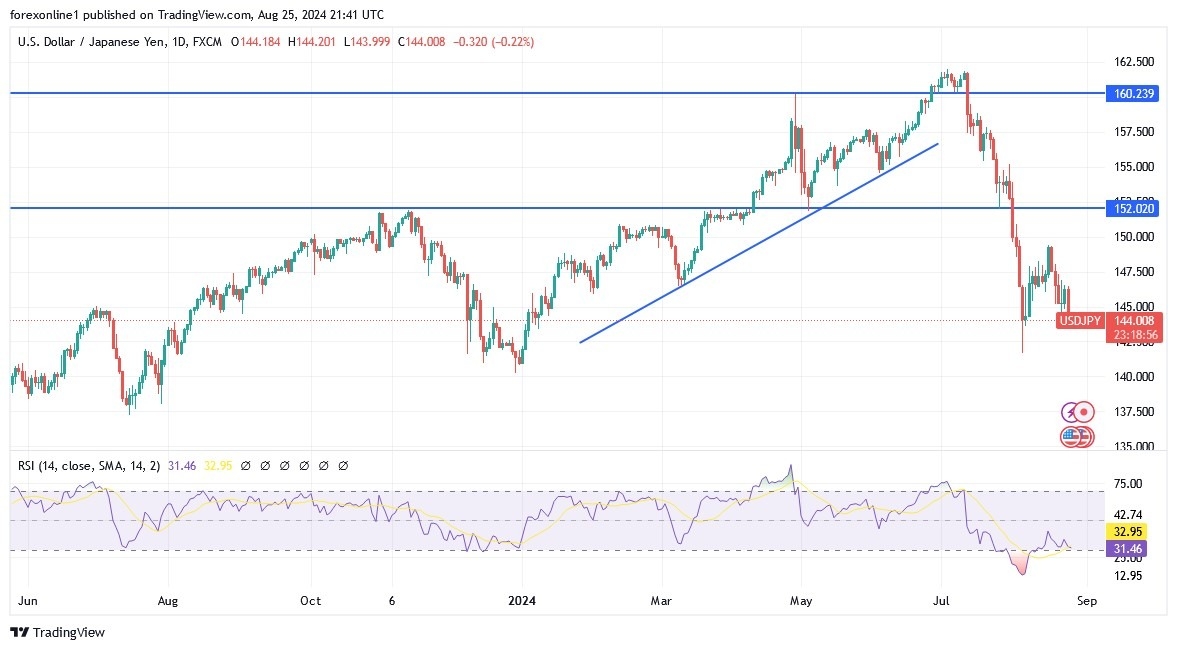- The Japanese Yen appreciated last Friday following a statement by Kazuo Ueda, Governor of the Bank of Japan.
- Also, the USD/JPY exchange rate retreated to 145.53 before a decisive statement from Jerome Powell, Chairman of the Federal Reserve.
- The currency pair had retreated by more than 10.18% from its highest point this year, meaning it was in a correction.
- Meanwhile, losses for the USD/JPY reached the support level of 144.05 before closing the trading session stable around the level of 144.33.

Rate hike by the Bank of Japan
According to reliable trading platforms, the USD/JPY pair fell as signs of divergence between the US Federal Reserve and the Bank of Japan emerged. In a statement before the Japanese parliament on Friday, Ueda indicated that the Bank of Japan may consider further interest rate hikes to combat stubbornly high inflation. Furthermore, such a move would mean that the divergence will continue because the US Federal Reserve will continue.
At the same time, recent economic data has shown that inflation in Japan has remained at a higher level in the past few years. The core consumer price index has remained at 2.8% for the past three months in a row, up from its year-to-date low of 2.2%. Overall, inflation in Japan remains lower than most countries. In the US, the core CPI fell to 2.9% in July, while in Australia it rose to 3.8% in the last quarter. However, the Japanese figure is notable because the country has not experienced any inflation in the past few decades.
For its part, the Bank of Japan hopes that its hawkish tone will lead to a relatively stronger currency that will make imports such as crude oil and natural gas cheaper in the country. Also, the Bank of Japan’s interest rate hike is important because other global central banks have either started or are considering cutting interest rates. In Europe, the European Central Bank has already cut interest rates from 4.50% to 4.25%.
Similarly, the Bank of England cut interest rates by 0.25% at its last meeting, while the Federal Reserve hinted that it would cut them in September.
Moreover, the Japanese Yen appreciated as hedge funds and other speculators turned bullish for the first time since 2021. In its latest Commitment of Traders report, the Commodity Futures Trading Commission said that net long positions by speculators such as hedge funds moved to 23,000 a week earlier. These funds had been very negative on the Japanese Yen, with the Commitment of Traders figure falling to a negative 184,000 in July.
Jackson Hole Symposium
Friday was an important day for the USD/JPY pair because Jerome Powell delivered a speech at the Jackson Hole Symposium, an annual gathering of central bank governors and economists. With no Federal Open Market Committee (FOMC) meeting this month, this meeting will be the main platform for Powell to provide hints on what to expect. The speech will come a day after the FOMC released its minutes, which showed that some members of the committee considered cutting interest rates at the last meeting.
Also, it will come after the Bureau of Labor Statistics revised up nonfarm payrolls (NFP) for the 12 months through May by more than 818,000, the largest number since 2009. The figures suggest the Labor market was weaker than expected and the unemployment rate could be higher than the current 4.3%. As such, the base case among many analysts is that Powell will signal a rate cut in September. While some analysts expect a large 0.50% cut, most believe the bank will cut by 0.25%. It is also likely to deliver at least two more cuts by the end of the year.
The Fed’s view was supported by the energy sector, with Brent and West Texas Intermediate (WTI) prices falling to $77.3 and $73, respectively. As a result, gasoline prices fell to their lowest level in more than 6 months, which means that inflation could continue to decline. Therefore, the Fed’s rate cuts, and the Bank of Japan’s rate hikes have narrowed the interest rate differential between the two countries. Thus, this differential could continue to narrow if the Bank of Japan continues to raise interest rates at its next meeting on September 20.
For a long time, the interest rate differential between the two countries has led to a risk-free carry trade opportunity that is now starting to ease.
Top Forex Brokers
USD/JPY Technical Analysis and Expectations Today
The USD/JPY exchange rate has been in a strong sell-off in the past few months. During this period, it has declined from its year-to-date high of 161.83 to 146. It is worth noting that the pair is about to form a death cross where the 200-day and 50-day moving averages are crossing each other and the US Dollar Index (DXY) is intensifying its decline. Technically, the MACD indicator has remained below the neutral point but is pointing up. Similarly, the Relative Strength Index (RSI) has moved slightly above the oversold level. Therefore, the USD/JPY pair is likely to continue to decline, with the next target to watch being this month’s low at 141.65 followed by the support at 140.00, its low point from December last year.
Ready to trade our USD/JPY Forex forecast? Here’s a list of some of the best regulated forex brokers to check out.
